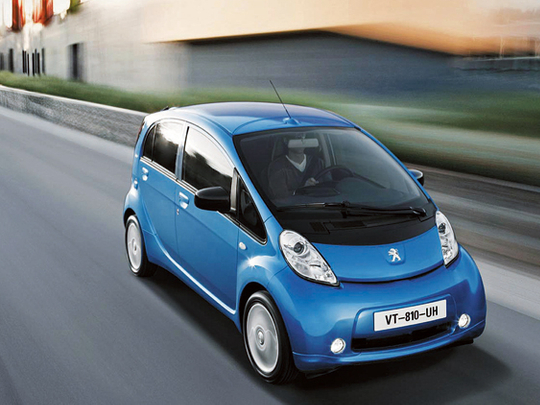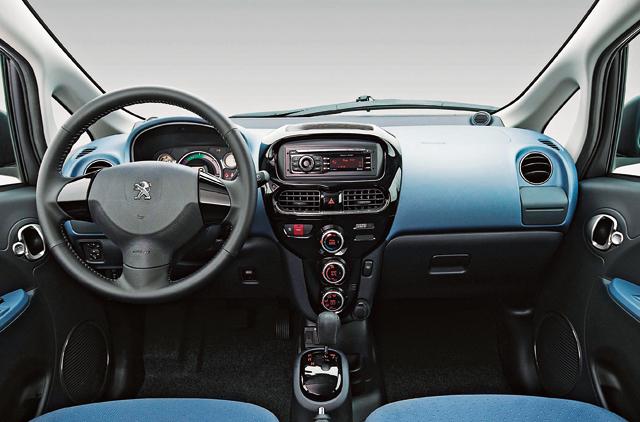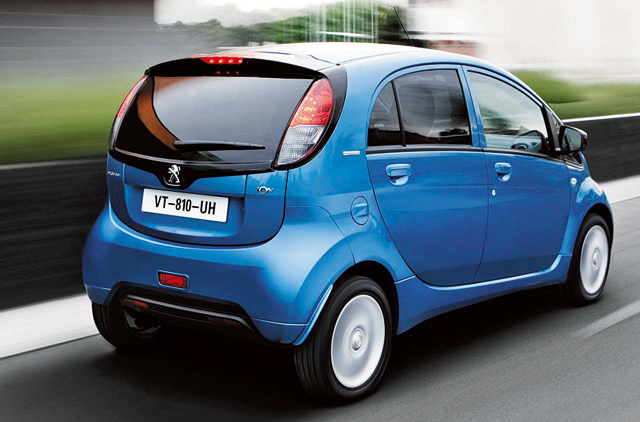
While most of us still scurry around in petrol-powered machines trying to save fuel wherever possible, what was once a dream is now a reality: in Europe and the US you can go out and buy a viable electric car tomorrow if you wish.
Most of the attention has been grabbed by the mass-produced, bespoke electric products such as the Nissan Leaf, but there are a number of options that can soften the blow of the initial purchase price by using some existing technology. The Peugeot iOn is just such a car.
The keen-eyed amongst you will have spotted where the iOn's origins lie: the very tall but slim body first appeared on Mitsubishi's i-car, but there's certainly nothing wrong with that: not only is the iOn attractive, with city motoring in mind the design makes perfect sense. The wheels are pushed towards the corners far more than in most cars, and with the high roof the cabin is deceptively spacious. The amount of headroom on offer would embarrass much more expensive cars and even with four passengers on board the boot offers up a useful 170 litres — more than the comparable Peugeot 107.
The cabin environment itself is also helped by the exterior design. You sit high up, and with the deep windscreen and generous windows the view out is excellent, just what is required for urban dodging and darting.
The specification is also surprisingly comprehensive: six airbags, ESP, Bluetooth and USB connectivity and air conditioning are all included — the only options are sat-nav, fancy paint and heating for the driver's seat and door mirrors.
Yet this is just the dressing, and what really matters is how the iOn drives. Like any pure electric car, the range is, by the standards of an internal combustion engine, relatively modest. On the standard European driving cycle by which all cars are measured, the iOn will get you 150km on a full charge. That of course is less than a car running on regular fuel, but then this is no ordinary car.
The iOn is clearly aimed at shorter journeys and particularly urban travel, which it is very well suited to: don't forget cities all over Europe are installing charging points in free parking zones all the time, and congestion charges are waived for zero emission vehicles.
What's more, the iOn recharges in around seven hours if you plug it in at home, or can be juiced up to 80 per cent of maximum battery in 30 minutes at a dedicated fast charger. From the driving seat it's all very familiar if you've driven an i-car before: a good view out, sound driving position and an attractively modern dashboard.
Turn the key and you're met with a beep rather than anything louder, and a light illuminates to tell you that the iOn is ready to go. There's still total silence as you slot the conventional automatic gearlever into D and gently squeeze the accelerator. Pulling away is thankfully a smoothly linear experience with no sudden lurch or rush of power: ease the pedal down, the iOn eases with you, all accompanied by near perfect silence.
Even as the speed rises towards 50kph, all you can hear is a very distant thrum as the tyres circulate and the electric motors go about their business. It transforms city driving into a far more relaxing experience as outside noises are kept at bay and the iOn does its best to stay hushed. Above 80kph there is a little more wind noise, but this just illustrates how quiet the rest of the car is.
You can also forget any idea of this being stuck at the back of the pack. Should you throw caution to the wind and call on maximum acceleration, the iOn will reach 100kph in 15.9 seconds, although the reality is it feels quicker than this and its acceleration to 50 or 70kphis much brisker. That translates into feeling completely confident about it having enough get up and go to pullout into traffic or squirt past slower vehicles. It feels as nippy as a modest city car, because that's exactly what it's designed to be.
It steers very sweetly too, helped by the low weight and the sharp turning circle, and despite the tall body it doesn't feel ungainly or held back by its shape. Compromised it is certainly not.
So what's the catch? Well the one key thing to remember is that Peugeot won't sell the iOn. If you were in the UK they would happily lease you one from one of 20 specialist dealerships for Dh2,399 which includes the lease of the car and the battery, full servicing for four years (including tyres and brakes) and 64,000km, with an option to continue for another four years at a reduced monthly fee.
Only you can decide if an electric car is right for you but the environmental argument is a pretty strong one, and with fuel seemingly going only in one direction, the economic one is stacking up too. That the iOn is a likeable, usable and practical electric car makes the change all the more appealing. And naturally, all this is purely academic because the iOn isn't coming here. Shame.
Specs
Model iOn
Engine Electric motor
Transmission Single-speed, RWD
Max power 66bhp
Max torque 180Nm
Top speed 130ph
0-100kph 15.9sec
Price Dh2,399/month (UK)
Plus Viable zero-emissions motoring...
Minus .... Just not here















